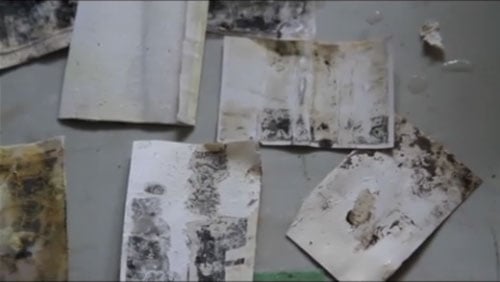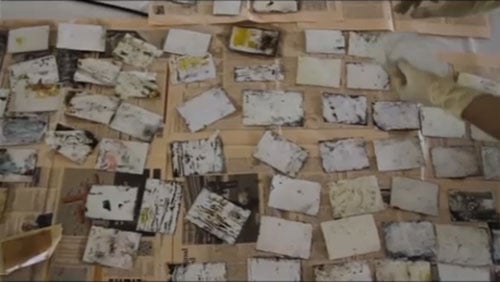Photographic Memories
By:
September 2, 2011
How do you retrieve a lost memory?
[Saving Memories: Recovered photographs from the 3.11 tsunami, Hikaru Toda, 2011]
Several disasters ago, Japan experienced one of its periodic earthquake/tsunami events, and people there have since turned to post-cataclysmic patience for clean-up and rebuilding.
But not all of this involves heavy lifting. Fujifilm employees, former employees, and their families are, on a volunteer basis, engaged in the delicate task of salvaging family photos. Washing, peeling, brushing, drying, stripping away mold, each photo receives a series of precise-yet-invasive treatments meant to preserve representation. “We are trying to protect the faces as much as possible.”

But sometimes almost the entire image is lost, leaving only rough polygons around edges, or writing on the back. Wherever possible, photos found together are kept together, along with what may remain of any albums, covers, pages or spines, in the hopes that somewhere in the web of connections an entire memory may be found. No photo, it seems, is an island.

Because what is a memory? In itself, nothing. A memory is a link, a connection to an experience, its meaning imprinted and embroidered with electrochemical imaging. A memory exists in the set of relationships between us, other people, some activity or situation, how we felt about that, various layers of interpretation and extension served through history, science, art and fantasy — and, sometimes, if we have time, the relevant documentation in the form of a photo, a souvenir, or perhaps even writing, a note scribbled lightly on the back. A memory exists as part of a web of embedded relations; without its embed, a link is not a link at all.


The salvage effort has been partially successful in its efforts; as successful as it can be. If the physical traces are strong enough, if the photos belong to someone still living, if the survivors stop by, if, by paging through the collections, they locate their lost markers, then a memory can be returned to its rightful owner. Or at least, the memory of a memory. “I’m drying them because these will be returned to the local areas to be given a memorial service of their own.”

And if not? The salvage effort still stands as concrete poetry, as we contemplate the wrinkled, empty rectangles, manifestations of memory palaces long since washed away.

[Sans Soleil, dir. Chris Marker, 1983]
The first image he told me about was of three children on a road in Iceland, in 1965. He said that for him it was the image of happiness and also that he had tried several times to link it to other images, but it never worked. He wrote me: one day I’ll have to put it all alone at the beginning of a film with a long piece of black leader; if they don’t see happiness in the picture, at least they’ll see the black.
